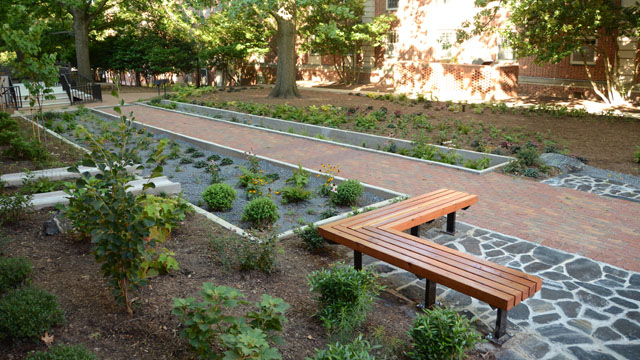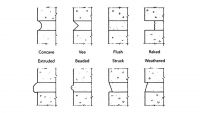January 2, 2012 2:10 PM CST
The Artist’s Backyard is a joint project between N.C. State University’s departments of Landscape Architecture and University Housing. It’s a plaza and rain garden between two older dormitories, Owen and Turlington Halls. It uses a combination of StormPave permeable pavers from Pine Hall Brick, along with materials that were recycled from a building demolition. New benches anchor a gathering spot where students visit with each other, read a book or text their friends.
Andrew Fox, an assistant professor at the NCSU College of Design, says The Artists Backyard is an outgrowth of last year’s renovation of Syme Hall on East Campus. Fox pursued a $20,000 teaching grant through the university to lead his students through a design-build exercise to improve the Syme Hall site from a muddy mess to a beautiful rain garden.
The success of that project prompted Dr. Tim Luckadoo, associate vice chancellor for student affairs, who oversees housing on campus, to talk with Fox about additional projects. Those discussions turned into $175,000 in funding and a five-year plan to improve the landscapes around several N.C. State residence halls.
It’s a win for both sides. Students get the real-world experience of designing and helping construct natural common areas, and the university gets cost-effective improvements to its surroundings.
Before The Artist’s Backyard was built, surging stormwater would carry leaves and other debris across the existing concrete sidewalk. The solution is to use Low Impact Development design techniques to slow, capture and clean stormwater on site. Cisterns and the permeable paver installation re-direct stormwater into the rain garden and the ground, effectively filtering it and preventing erosion.
Nine days after the installation was complete, Mother Nature handed the college students a pop quiz. Thunderstorms rolled across central North Carolina and dropped 4.69 inches of rain, amounting to a 100-year flood.
“The surface water drained into the rain garden and it was dry, no puddling,” says Fox. “The rain garden had handled that huge pulse of rain water. After four hours, the test wells were slowly infiltrating and the water was not standing.”
The Artist’s Backyard furthers green initiative
Green education
By Masonry

The Artist’s Backyard
It stands to reason that teaching green construction techniques to today’s students also bodes well for the future of construction. That future will center on using sustainable materials within projects with a role to play in protecting the planet.The Artist’s Backyard is a joint project between N.C. State University’s departments of Landscape Architecture and University Housing. It’s a plaza and rain garden between two older dormitories, Owen and Turlington Halls. It uses a combination of StormPave permeable pavers from Pine Hall Brick, along with materials that were recycled from a building demolition. New benches anchor a gathering spot where students visit with each other, read a book or text their friends.
Andrew Fox, an assistant professor at the NCSU College of Design, says The Artists Backyard is an outgrowth of last year’s renovation of Syme Hall on East Campus. Fox pursued a $20,000 teaching grant through the university to lead his students through a design-build exercise to improve the Syme Hall site from a muddy mess to a beautiful rain garden.
The success of that project prompted Dr. Tim Luckadoo, associate vice chancellor for student affairs, who oversees housing on campus, to talk with Fox about additional projects. Those discussions turned into $175,000 in funding and a five-year plan to improve the landscapes around several N.C. State residence halls.
It’s a win for both sides. Students get the real-world experience of designing and helping construct natural common areas, and the university gets cost-effective improvements to its surroundings.
Before The Artist’s Backyard was built, surging stormwater would carry leaves and other debris across the existing concrete sidewalk. The solution is to use Low Impact Development design techniques to slow, capture and clean stormwater on site. Cisterns and the permeable paver installation re-direct stormwater into the rain garden and the ground, effectively filtering it and preventing erosion.
Nine days after the installation was complete, Mother Nature handed the college students a pop quiz. Thunderstorms rolled across central North Carolina and dropped 4.69 inches of rain, amounting to a 100-year flood.
“The surface water drained into the rain garden and it was dry, no puddling,” says Fox. “The rain garden had handled that huge pulse of rain water. After four hours, the test wells were slowly infiltrating and the water was not standing.”
Originally published in Masonry magazine.
About the Author
Masonry, the official publication of the Mason Contractors Association of America, covers every aspect of the mason contractor profession - equipment and techniques, building codes and standards, business planning, promoting your business, legal issues and more. Read or subscribe to Masonry magazine at www.masonrymagazine.com.


















